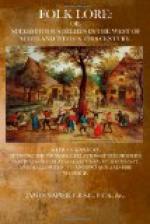“Pause while we keep these
rites, ye widowed dames,
The marriage time a purer
season claims;
Pause, ye fond mothers, braid
not yet her hair,
Nor the ripe virgin for her
lord prepare.
O, light not, Hymen, now your
joyous fires,
Another torch nor yours the
tomb requires!
Close all the temples on these
mourning days,
And dim each altar’s
spicy, steaming blaze;
For now around us roams a
spectred brood,
Craving and keen, and snuffing
mortal food:
They feast and revel, nor
depart again,
Till to the month but ten
days more remain.”
Superstitions of this sort linger much longer in the country than in towns, and the larger the town the more speedily do they die out; but, judging from the statistics of late years, this superstition has still a firm hold of the inhabitants of Glasgow, the second city of the Empire. During the year 1874 the marriages in May were only 204, against 703 in June; but as the removal term occurs at the end of May, that must materially affect the relations, in this respect, between May and June, and accounts, in part, for the great excess of marriages in June. But if the average of the eleven months, excluding May, be taken, then during that year there was a monthly average of 441, against 204 in May—being rather more than double. For the ten years preceding 1874, the average of the eleven months was 388, against 203 in May. As if to compensate for the restraint put upon the people in May, Juno, the wife of Jupiter, after whom June was named, and whose influence was paramount during that month, took special guardianship over births and marriages; hence June was a lucky month to be born in or get married in, and thus June is known as the marrying month. Here, again, our registers show that the number of marriages are in June nearly double the average of the other months, excluding May and June. The average during the ten years is, for the ten months, 375 per month, whilst the average for June is 598. It may be noticed in passing that, in Glasgow, January and July stand as high as June, owing, doubtless, to the holidays which occur during these two months making marriage at those times more convenient for the working classes.
There were many marriage observances of a religious or superstitious character practised in ancient Rome which were quite common among us within this century, especially in the country districts, but which now are either extinct or fast dying out. When a Roman girl was betrothed, she received from her intended a ring which she wore as evidence of her betrothal. When betrothed she laid aside her girlish or maiden dress,—some parts of which were offered as a sacrifice to the household gods,—and she was then clothed in the dress of a wife, and secluded from her former companions, and put under training for her new duties. When the time drew near for the consummation of the ceremony, it became an important




